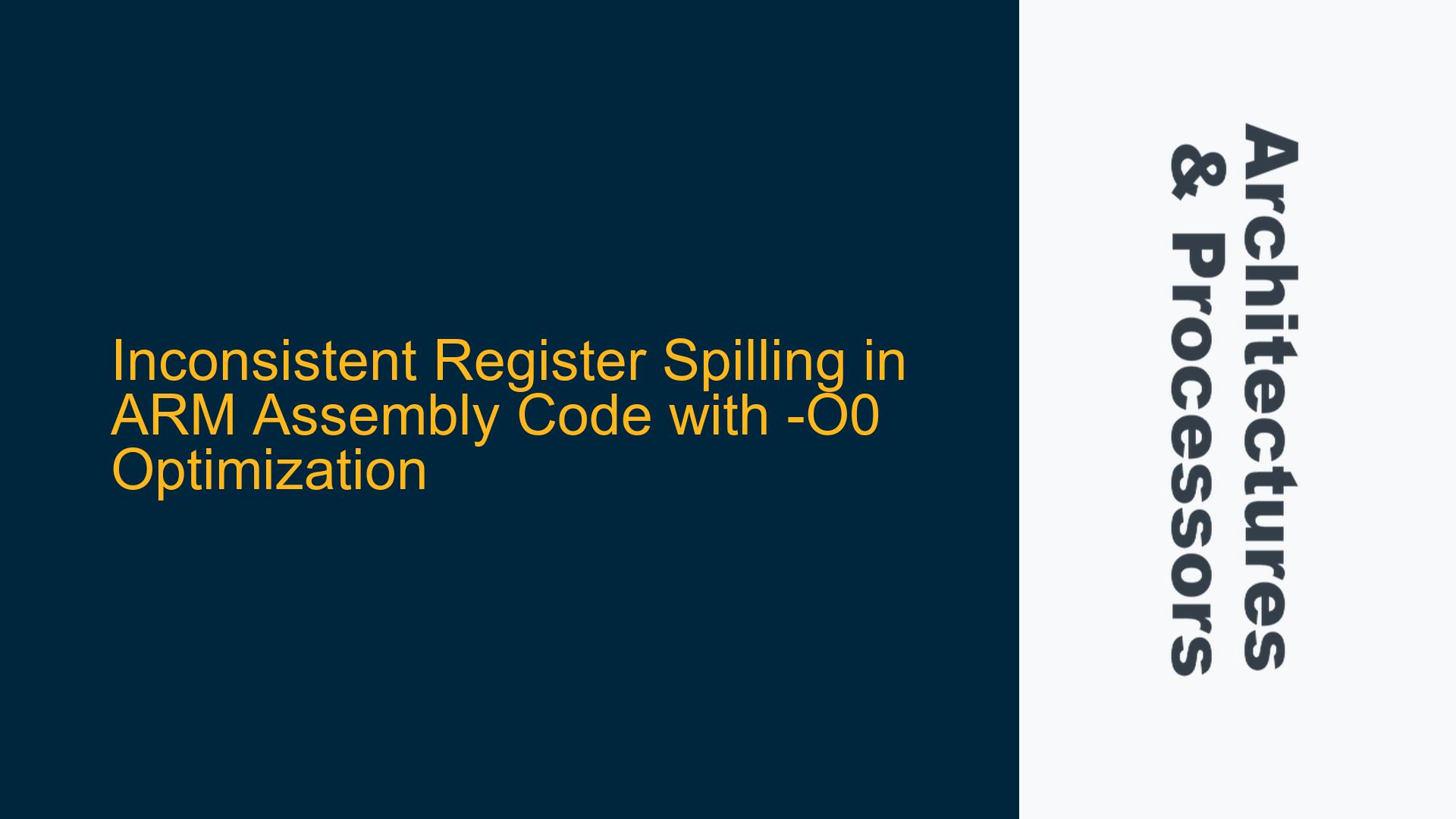ARM Cortex-M Register Spilling Behavior Under -O0 Optimization
When compiling C/C++ code for ARM Cortex-M processors using the -O0 optimization flag, developers often observe inconsistent behavior in how the compiler handles register spilling. Register spilling refers to the process of storing register contents into RAM (typically the stack) to free up registers for other operations. This behavior is particularly noticeable when comparing the assembly output of two similar pieces of code. One code snippet may exhibit minimal spilling, with most variables retained in registers, while another may spill nearly all variables to RAM. This inconsistency can lead to confusion, especially when attempting to benchmark or analyze the performance of the compiled code.
The root of this issue lies in the interaction between the compiler’s code generation strategy, the ARM architecture’s register limitations, and the specific constraints imposed by the -O0 optimization level. At -O0, the compiler prioritizes debuggability and straightforward code generation over performance or register efficiency. This often results in suboptimal register usage, as the compiler avoids making assumptions about variable lifetimes or reusing registers aggressively. However, the exact behavior can vary depending on the compiler version (e.g., AC5 vs. AC6), the structure of the code, and the number of variables in use.
For example, in the first code snippet, variables such as pOut2, pBias, pB, pB2, and pA2 remain in registers and are not spilled to RAM. In the second snippet, nearly all variables are spilled to RAM, resulting in additional STR (store) instructions that consume clock cycles and degrade performance. This inconsistency makes it difficult to predict or control the behavior of the compiled code, particularly when performance is a critical concern.
Compiler Heuristics and Register Allocation Under -O0
The inconsistent register spilling behavior observed under -O0 optimization can be attributed to several factors related to compiler heuristics and the ARM architecture’s register allocation mechanisms. Understanding these factors is essential for diagnosing and addressing the issue.
Limited Register Availability
ARM Cortex-M processors have a relatively small number of general-purpose registers (e.g., 13 in ARMv7-M). When compiling with -O0, the compiler does not aggressively optimize register usage, often treating each variable as having a distinct lifetime. This conservative approach can lead to excessive spilling, especially in functions with many local variables or complex control flow. The compiler may spill variables to RAM even when they could theoretically remain in registers, simply because it lacks the sophistication to analyze and optimize their usage at this optimization level.
Compiler-Specific Behavior
Different versions of the ARM Compiler (e.g., AC5 vs. AC6) may exhibit varying behavior under -O0. For instance, AC6 tends to produce more consistent assembly output, with most variables spilled to RAM, while AC5 may show greater variability. This discrepancy arises from differences in the underlying code generation algorithms and heuristics used by each compiler. AC6’s more predictable behavior may be preferable for debugging, but it can also result in less efficient code compared to AC5’s more variable approach.
Code Structure and Variable Usage
The structure of the code and the way variables are used can also influence register spilling. For example, variables that are used frequently or across multiple basic blocks may be more likely to remain in registers, while those used infrequently or in isolated contexts may be spilled to RAM. Additionally, the presence of function calls, loops, or conditional statements can complicate the compiler’s register allocation decisions, leading to inconsistent spilling behavior.
Debugging Constraints
The -O0 optimization level is explicitly designed to facilitate debugging by generating straightforward, unoptimized code. This includes preserving the relationship between source code and assembly instructions, making it easier to set breakpoints and inspect variable values. However, this design goal often conflicts with efficient register usage, as the compiler prioritizes debuggability over performance. As a result, developers may observe seemingly arbitrary spilling behavior that is difficult to rationalize without understanding the compiler’s priorities.
Strategies for Minimizing Register Spilling and Improving Performance
To address the issue of inconsistent register spilling and improve the performance of ARM Cortex-M code, developers can adopt several strategies. These approaches range from adjusting compiler settings to modifying the code itself, with the goal of maximizing register usage and minimizing unnecessary RAM accesses.
Increasing Optimization Levels
The most straightforward solution is to increase the optimization level beyond -O0. Higher optimization levels (e.g., -O1, -O2, or -O3) enable the compiler to apply more sophisticated register allocation algorithms, reducing the likelihood of unnecessary spilling. For example, at -O1, the compiler may reuse registers more aggressively and analyze variable lifetimes to minimize RAM accesses. However, higher optimization levels can also make debugging more challenging, as the relationship between source code and assembly instructions becomes less direct.
Using Compiler-Specific Pragmas and Attributes
Some ARM compilers support pragmas or attributes that allow developers to influence register allocation decisions. For example, the register keyword in C can be used to suggest that a variable should be kept in a register, although the compiler is not obligated to honor this request. Additionally, compiler-specific attributes (e.g., __attribute__((always_inline)) in GCC) can be used to control inlining behavior, which can indirectly affect register usage.
Restructuring Code for Better Register Utilization
Developers can also modify their code to improve register utilization. This includes reducing the number of local variables, minimizing the scope of variables, and avoiding complex control flow structures that complicate register allocation. For example, breaking large functions into smaller, more focused functions can help the compiler manage registers more effectively. Similarly, using arrays or structures judiciously can reduce the number of individual variables that need to be tracked.
Analyzing Assembly Output
To gain deeper insights into register spilling behavior, developers can analyze the assembly output generated by the compiler. This involves compiling the code with the -S flag to produce an assembly file, which can then be examined to identify unnecessary STR and LDR (load) instructions. By correlating these instructions with the source code, developers can pinpoint specific variables or code segments that are contributing to excessive spilling and take targeted action to address them.
Leveraging Compiler Documentation and Community Resources
Finally, developers should consult the documentation for their specific compiler version to understand its behavior and available optimization options. Additionally, community forums and resources can provide valuable insights and best practices for minimizing register spilling and improving performance on ARM Cortex-M processors. By combining these resources with hands-on experimentation, developers can achieve a more consistent and efficient compilation process.
In conclusion






